We’ve all dreamed of that perfect garage setup where our prized vehicles sit protected from the elements while showcasing our automotive passion. Whether you’re a weekend warrior with a classic muscle car or a daily commuter seeking better organization your garage represents more than just storage space.
Your garage holds untapped potential to become the ultimate automotive sanctuary. From proper ventilation systems that prevent moisture damage to strategic lighting that highlights your vehicle’s best features we’ll explore how to transform your ordinary garage into an extraordinary car haven.
The benefits extend beyond aesthetics too. Well-organized garages protect your investment increase your home’s value and create functional workspace for maintenance and detailing. We’re here to guide you through every step of creating the garage setup you’ve always wanted.
Essential Benefits of Storing Cars in Garage Spaces
Moving beyond the aesthetic and organizational aspects of our automotive sanctuary, we need to examine the fundamental advantages that make garage storage essential for vehicle ownership.
Protection From Weather Elements
Weather exposure damages our vehicles in countless ways throughout the year. UV rays from direct sunlight fade paint finishes and crack dashboard materials, while extreme temperatures cause rubber seals to deteriorate and metal components to expand and contract repeatedly.
Rain and snow create moisture problems that lead to rust formation on body panels and undercarriages. Hail storms can cause thousands of dollars in dent damage within minutes, and freezing temperatures make starting engines more difficult while reducing battery life significantly.
Garages shield our cars from these destructive forces completely. Temperature regulation inside enclosed spaces prevents the extreme fluctuations that stress vehicle systems, and protection from precipitation eliminates moisture related corrosion issues entirely.
Enhanced Security and Theft Prevention
Vehicle theft rates drop dramatically when cars stay inside locked garage spaces. According to the National Insurance Crime Bureau, vehicles parked in driveways face theft rates 50% higher than those stored in garages.
Closed garage doors conceal our vehicles from potential thieves who target exact makes and models. Visibility plays a crucial role in theft selection, and criminals typically avoid properties where they cannot easily assess what’s available to steal.
Security systems integrate more effectively with garage storage answers. Motion sensors, cameras, and alarm systems work together to create multiple layers of protection that deter break ins and provide evidence if incidents occur.
Preservation of Vehicle Value
Garage stored vehicles retain higher resale values compared to those parked outdoors year round. Automotive industry data shows that cars kept in garages maintain up to 15% more value over five year periods due to reduced wear and cosmetic damage.
Paint condition remains significantly better on garage kept vehicles. Professional appraisers consistently note superior finish quality on cars that avoid daily sun exposure and weather contact throughout their ownership periods.
Mechanical components last longer when protected from environmental stresses. Engine parts, electrical systems, and rubber components all benefit from stable temperature conditions and reduced moisture exposure that garage storage provides consistently.
Top Garage Types for Cars in Garage Storage
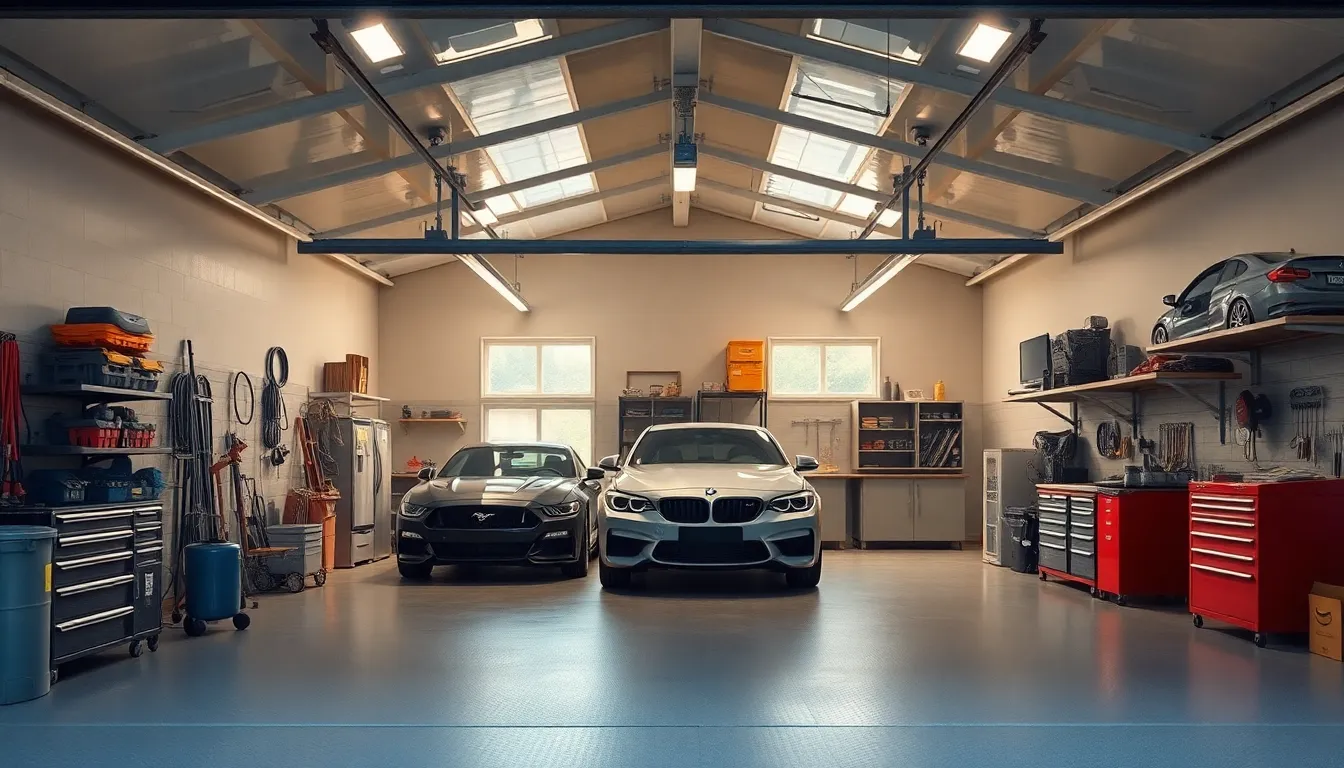
Different garage configurations offer unique advantages for automotive storage, each designed to meet exact needs and property layouts. Understanding these options helps us select the most suitable setup for protecting our vehicles.
Attached Single-Car Garages
Attached single-car garages provide the most convenient access from our homes while maintaining cost-effective storage answers. These compact spaces typically measure 12 feet by 20 feet, offering enough room for most standard vehicles with minimal storage around the perimeter.
Direct home access through interior doors makes these garages ideal for daily drivers we use frequently. The shared wall construction reduces building costs by approximately 20% compared to detached structures, making them popular choices for suburban developments.
Temperature regulation benefits from the shared wall with our heated homes, protecting vehicles from extreme weather fluctuations. We can easily install electrical connections for car chargers, automatic door openers, and lighting systems through existing home circuits.
Storage limitations require careful organization to accommodate both our vehicle and essential garage items like tools, seasonal equipment, and cleaning supplies.
Detached Multi-Car Garages
Detached multi-car garages offer expansive storage capacity ranging from two to six vehicle spaces with additional workshop areas. These structures typically feature 24-foot by 24-foot dimensions for two-car configurations, with larger options extending to 30 feet by 40 feet or more.
Complete separation from our homes provides enhanced security for valuable classic cars, sports vehicles, and automotive collections. The isolated location reduces noise transmission from power tools, air compressors, and vehicle engines during maintenance work.
Customization opportunities include specialized flooring systems, lift installations, and dedicated workspace zones without impacting our home’s structure. We can design these garages with higher ceilings to accommodate larger vehicles like trucks, SUVs, or recreational vehicles.
Insurance considerations often favor detached structures for storing high-value vehicles, as they present lower fire risks to our primary residences.
Underground Parking Structures
Underground parking structures deliver maximum security and weather protection through subterranean construction methods. These systems maintain consistent temperatures year-round, typically staying between 50-60°F regardless of external weather conditions.
Space efficiency allows multiple vehicle storage within compact urban lots where surface area is limited. The below-ground design preserves our property’s landscaping and outdoor living spaces while providing discrete vehicle storage.
Construction costs range from $15,000 to $40,000 per vehicle space depending on excavation requirements and structural complexity. Professional engineering ensures proper drainage, ventilation systems, and moisture control to prevent condensation issues.
Access mechanisms include hydraulic lifts, ramp systems, or automated parking platforms that transport vehicles between surface and underground levels. These sophisticated systems require regular maintenance but offer unparalleled protection from theft, vandalism, and environmental damage.
Smart Organization Systems for Cars in Garage
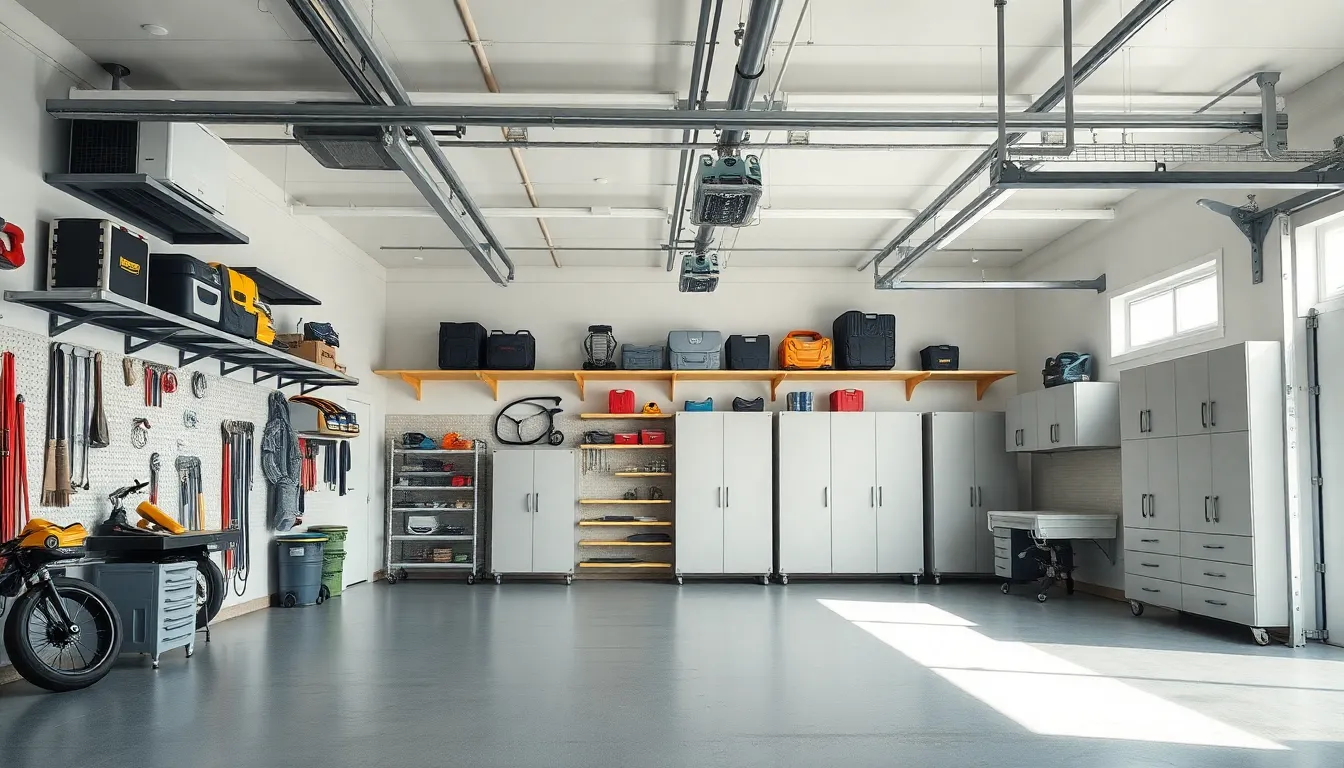
Maximizing storage while maintaining easy vehicle access requires strategic organization systems that work vertically and horizontally. Smart storage answers transform cluttered garage spaces into functional automotive sanctuaries where every tool and accessory has its designated place.
Wall-Mounted Storage Answers
Wall-mounted systems use vertical space effectively while keeping essential items within arm’s reach of parked vehicles. Pegboard panels accommodate frequently used tools like wrenches, screwdrivers, and cleaning supplies, creating customizable storage that adapts to changing needs. Slatwall systems offer heavy-duty mounting options for larger items such as extension cords, car covers, and detailing equipment.
Heavy-duty wall hooks support seasonal items including snow tires, bike racks, and roof cargo boxes that typically clutter garage floors. Magnetic tool strips hold metal tools securely against walls, preventing them from falling and potentially scratching vehicle surfaces. Cabinet systems with locking mechanisms protect valuable automotive fluids, chemicals, and precision instruments from unauthorized access while maintaining organization.
Overhead Ceiling Storage
Ceiling storage systems capitalize on unused overhead space without interfering with vehicle parking areas below. Pulley systems lift seasonal items like kayaks, surfboards, and camping gear to ceiling level using simple rope and block mechanisms. Platform hoists accommodate bulky storage containers filled with holiday decorations, sporting equipment, and rarely used household items.
Suspended shelving units hang from ceiling joists using heavy-duty brackets rated for 200+ pounds per shelf. Bike lifts raise bicycles vertically against walls or horizontally beneath ceiling areas, freeing valuable floor space for vehicle maneuvering. Motorized garage lifts handle extremely heavy items such as boat engines, motorcycle parts, and industrial equipment with push-button convenience.
Floor Space Optimization Tools
Modular storage cabinets on wheels roll between parking spaces to maximize accessibility while minimizing permanent floor footprint. Rolling toolboxes position essential automotive maintenance supplies exactly where needed during repair sessions, then move aside for normal parking. Foldable workbenches extend when projects require surface space but collapse flat against walls when vehicles need full garage access.
Interlocking floor tiles create defined zones for parking, working, and storage while protecting concrete surfaces from oil stains and chemical spills. Corner storage units use typically wasted triangular spaces for items like car care products, emergency supplies, and seasonal automotive accessories. Retractable hose reels mount to walls or ceilings but extend across entire garage areas for washing vehicles without dragging heavy hoses across floors.
Climate Control Considerations for Cars in Garage
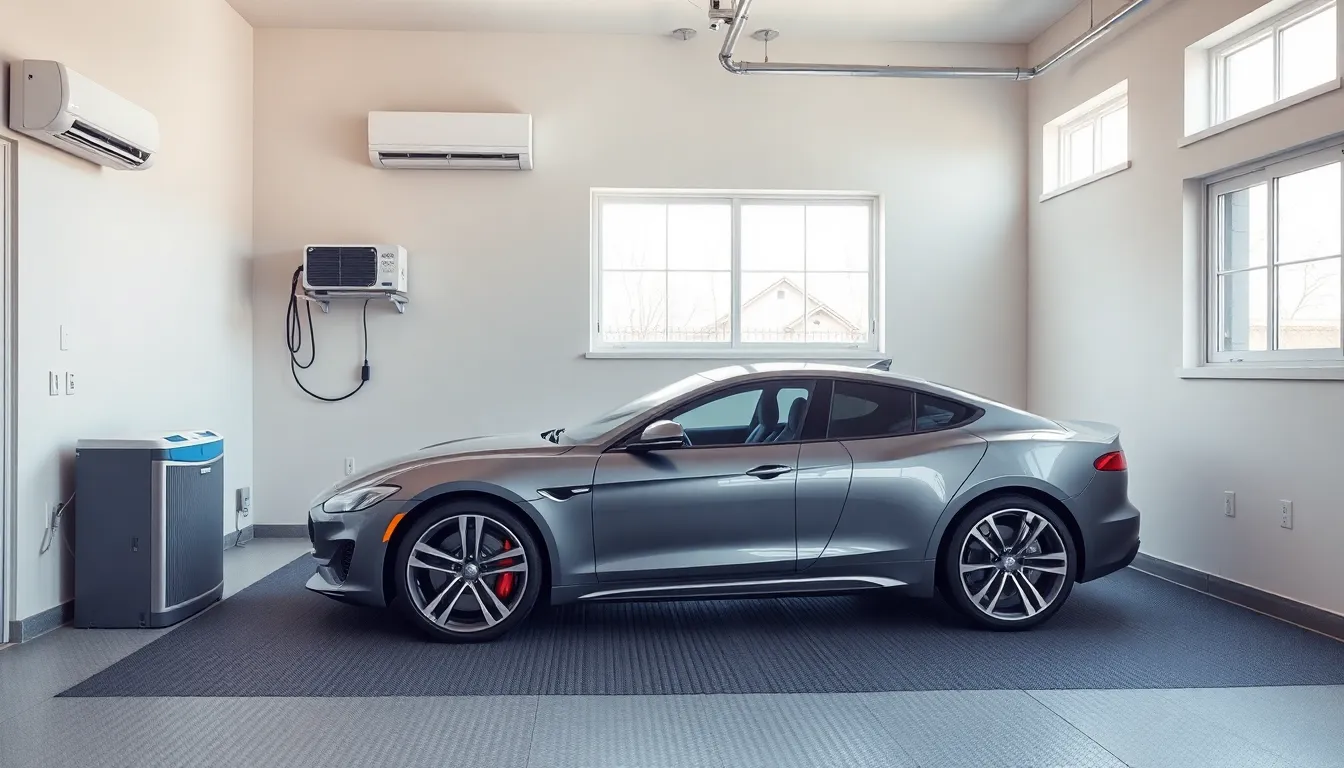
Creating the perfect climate environment protects our vehicles from temperature extremes and moisture damage while maintaining optimal storage conditions year-round.
Temperature Regulation Systems
HVAC integration delivers consistent temperature control by connecting garage systems to our home’s central air conditioning and heating units. Most residential HVAC systems can accommodate garage additions with proper ductwork installation and zone controls. Mini-split systems offer targeted cooling and heating specifically designed for garage spaces, providing energy-efficient operation with temperatures ranging from 60-75°F.
Radiant floor heating maintains steady warmth during winter months by circulating heated water through tubes installed beneath concrete floors. This system prevents condensation buildup while keeping vehicles at ideal storage temperatures. Electric radiant panels mounted on walls provide supplemental heating for smaller garage spaces, consuming approximately 750-1500 watts per unit.
Garage heaters include natural gas units, propane models, and electric infrared systems designed for automotive storage areas. Gas-fired heaters typically produce 30,000-80,000 BTUs and require proper venting for safe operation. Electric models range from 3,000-7,500 watts and plug directly into standard outlets for convenience.
Humidity Management Answers
Dehumidifiers remove excess moisture from garage air to prevent rust formation and paint deterioration on our stored vehicles. Whole-house units integrate with existing HVAC systems to maintain 40-50% relative humidity levels automatically. Portable dehumidifiers with 50-70 pint capacities work effectively in standard two-car garages.
Vapor barriers installed on concrete floors and walls block moisture infiltration from ground sources and exterior elements. Epoxy floor coatings create seamless moisture barriers while providing durable surfaces for vehicle storage. Plastic sheeting applied to concrete walls reduces condensation by 60-80% according to building science research.
Air circulation fans promote consistent airflow to prevent stagnant air pockets where moisture accumulates around our vehicles. Exhaust fans rated at 200-400 CFM effectively remove humid air from garage spaces. Oscillating pedestal fans provide gentle air movement around parked vehicles without creating dust circulation.
Ventilation Requirements
Natural ventilation utilizes strategically placed vents and windows to create cross-breezes that remove stale air and automotive fumes naturally. Ridge vents installed along roof peaks work with soffit vents to establish continuous airflow patterns. Operable windows on opposite walls generate effective air exchange rates of 4-6 air changes per hour.
Mechanical ventilation systems include exhaust fans triggered by carbon monoxide sensors and automatic garage door openers with built-in ventilation cycles. Whole-house fans can extend into garage areas to remove heated air during summer months. Heat recovery ventilators capture energy from outgoing air while bringing in fresh outdoor air.
Code compliance standards require garages to maintain minimum ventilation rates of 100 cubic feet per minute for attached spaces and 50 CFM for detached buildings. Building codes mandate carbon monoxide detection systems in garages connected to living spaces. Proper ventilation prevents dangerous gas accumulation while maintaining air quality for our stored vehicles.
Security Measures to Protect Cars in Garage
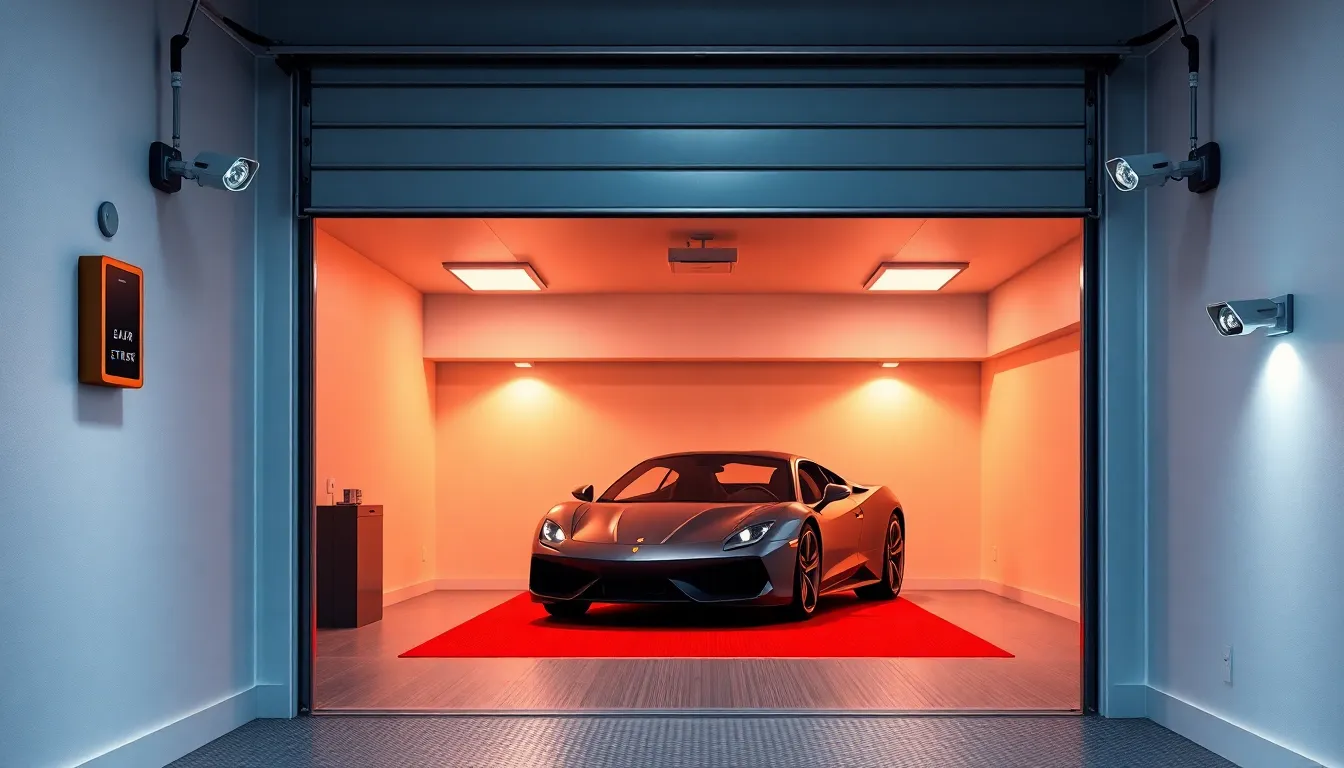
Securing our vehicles in garage spaces requires layered protection strategies that deter theft and unauthorized access. We’ll explore comprehensive security upgrades that transform ordinary garages into fortified automotive sanctuaries.
Advanced Door Lock Systems
Smart lock technology revolutionizes garage security by offering keyless entry through smartphone apps and biometric scanners. We can install Wi-Fi enabled locks that send real-time alerts when doors open or close, providing instant notifications about garage activity. These systems typically feature backup power sources and manual override capabilities for emergencies.
Deadbolt reinforcement strengthens entry points with Grade 1 security ratings that resist forced entry attempts for up to 10 minutes. We recommend installing deadbolts with 1-inch throw lengths and strike plates secured with 3-inch screws into door frames. Multi-point locking systems distribute force across several contact points, making doors nearly impossible to breach.
Keypad entry systems eliminate the risk of lost or stolen keys while allowing us to create unique access codes for family members and service personnel. We can program temporary codes for contractors and delete them remotely when projects complete. These systems often integrate with home security networks and provide detailed access logs for monitoring garage usage patterns.
Motion Sensor Lighting
Perimeter motion detectors activate bright LED floodlights when movement occurs within 30 feet of garage entrances, startling potential intruders and alerting homeowners. We position sensors at optimal heights of 9-10 feet to prevent tampering while maintaining coverage angles of 120 degrees. These lights typically consume only 20-30 watts while producing 2,000-3,000 lumens of deterrent illumination.
Interior motion activation ensures we never enter dark garage spaces, automatically illuminating work areas and vehicle storage zones when doors open. We install ceiling-mounted sensors that distinguish between large movements like cars and smaller motions from pets or debris. These systems can delay shutoff for 5-15 minutes, giving us adequate time to complete tasks before darkness returns.
Solar-powered backup lighting maintains security coverage during power outages, charging during daylight hours and activating automatically when grid electricity fails. We recommend units with lithium batteries that operate for 8-12 hours continuously and feature adjustable sensitivity settings. These lights often include built-in sirens that sound when motion triggers activation after sunset.
Security Camera Installation
High-definition surveillance systems capture clear footage of garage interiors and approaches, recording license plates and facial features in 4K resolution. We position cameras at multiple angles to eliminate blind spots, focusing on entry points, vehicle storage areas, and valuable tool collections. Modern systems offer 30-day cloud storage and smartphone viewing capabilities for remote monitoring.
Night vision technology ensures 24-hour surveillance using infrared illumination that’s invisible to intruders but provides clear black and white imagery. We install cameras with 850nm IR wavelengths that penetrate darkness up to 100 feet while maintaining sharp detail quality. These systems automatically switch between day and night modes based on ambient light conditions.
Integration with alarm systems creates comprehensive security networks that trigger multiple responses when breaches occur, including police notifications and smartphone alerts. We connect cameras to central monitoring stations that verify alarms before dispatching emergency services, reducing false alarm fees. These integrated systems often qualify for homeowner’s insurance discounts of 5-15% annually.
Maintenance Tips for Cars in Garage Storage
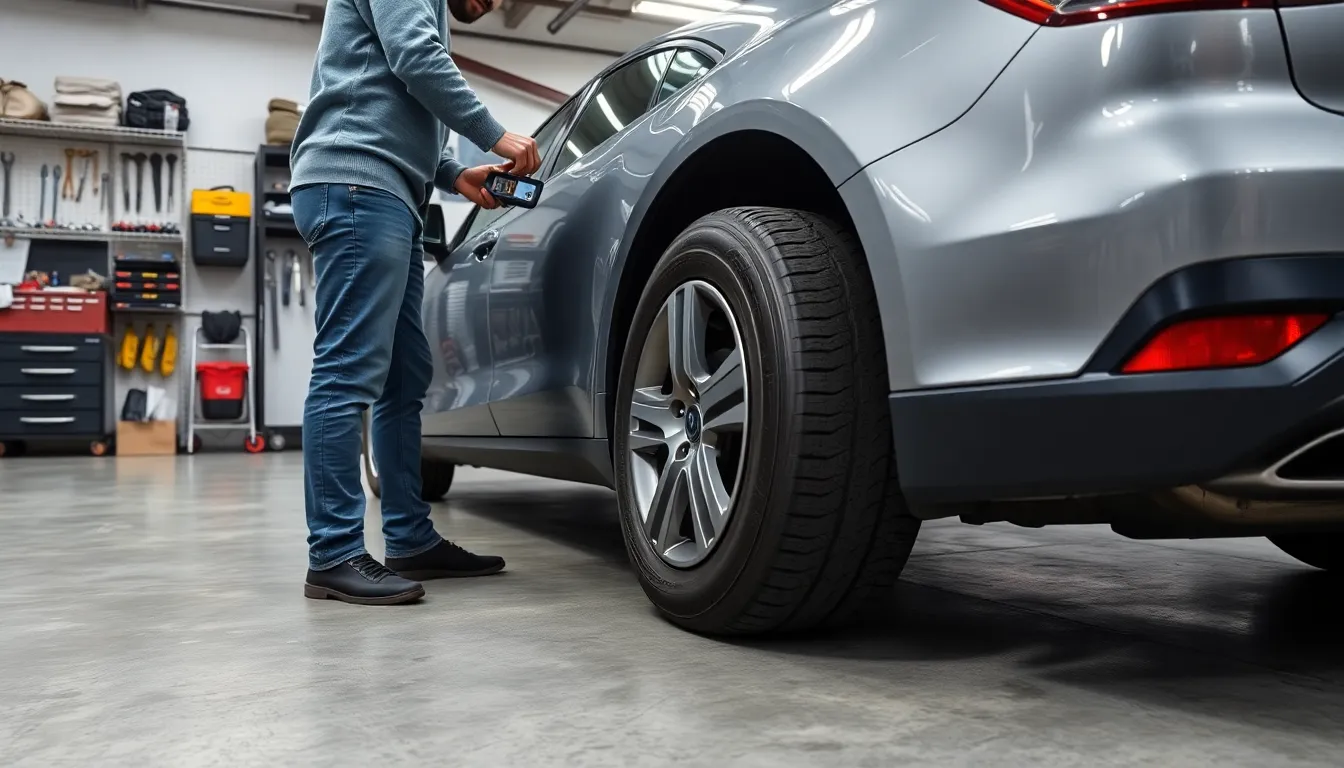
Proper maintenance becomes essential when storing vehicles in garage spaces for extended periods. We’ll guide you through the critical steps that keep your automotive investment in peak condition during storage.
Regular Cleaning Schedules
Weekly washing prevents dust accumulation and maintains your vehicle’s protective finish while stored in the garage. We recommend using microfiber cloths to gently remove particles from paint surfaces, avoiding scratches that can occur from abrasive materials.
Monthly interior cleaning keeps upholstery fresh and prevents odors from developing in enclosed garage environments. Focus on vacuuming seats and carpets to remove debris that attracts moisture and insects.
Quarterly waxing sessions create protective barriers against humidity and temperature fluctuations common in garage storage. Apply high-quality automotive wax to maintain paint integrity and prevent oxidation during long-term storage periods.
Battery and Fluid Monitoring
Battery voltage checks every two weeks prevent unexpected failures and extend battery life in stored vehicles. We suggest using digital multimeters to measure voltage levels, which should maintain readings above 12.4 volts for optimal performance.
Monthly fluid inspections ensure engine oil, coolant, and brake fluid remain at proper levels and quality standards. Check for contamination signs like discoloration or unusual odors that indicate necessary fluid changes.
Seasonal battery maintenance includes cleaning terminals and applying protective spray to prevent corrosion buildup. Consider using battery tenders or maintainers for vehicles stored longer than 30 days to prevent complete discharge.
Tire Pressure Management
Weekly pressure checks maintain optimal tire health and prevent flat spots during extended garage storage. We recommend checking all four tires plus the spare using accurate digital pressure gauges for consistent readings.
Monthly tire rotations distribute weight evenly and prevent permanent deformation when vehicles remain stationary for weeks. Move your car several feet forward or backward to change contact points with the garage floor.
Quarterly pressure adjustments account for seasonal temperature changes that naturally affect tire inflation levels. Cold weather reduces pressure by approximately 1 PSI for every 10-degree temperature drop, requiring regular monitoring during winter storage periods.
Common Mistakes When Parking Cars in Garage
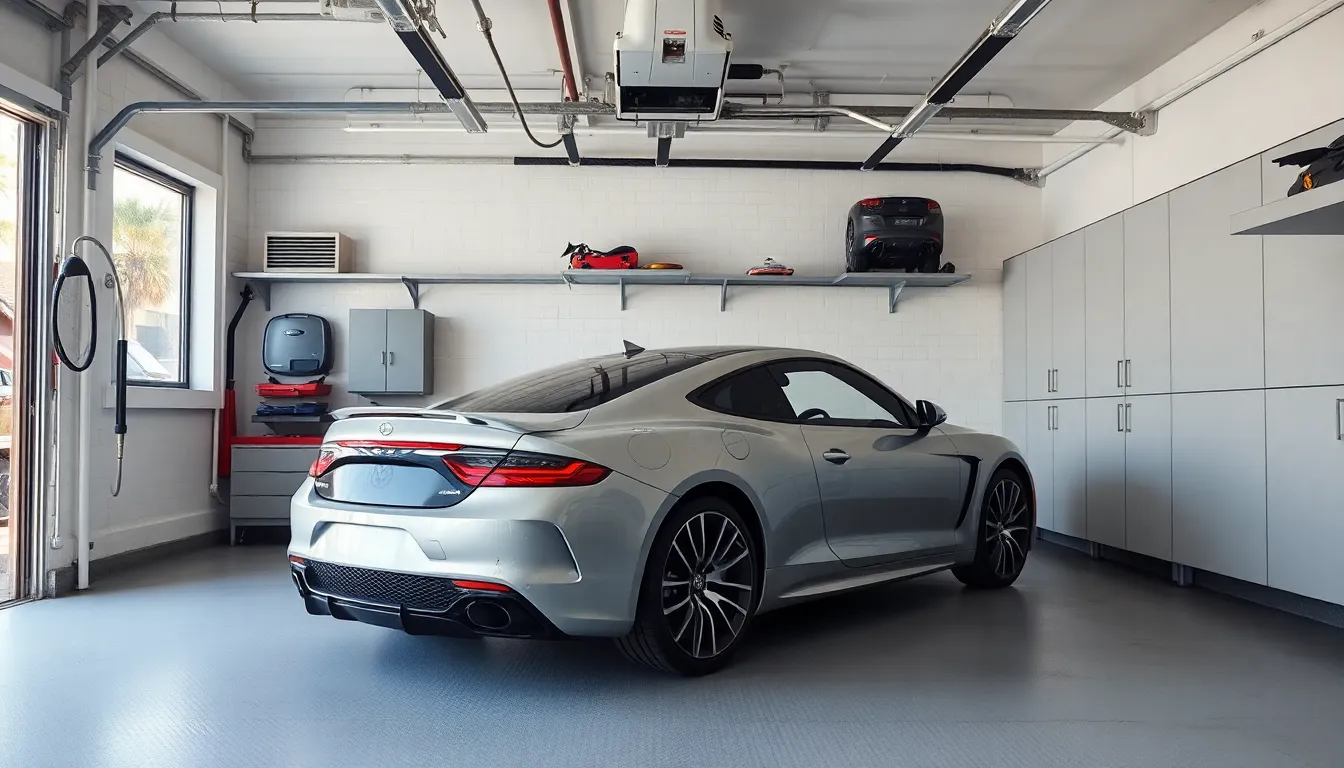
We’ve seen countless garage storage setups that fall short of their potential due to easily avoidable errors. These oversights can transform your automotive sanctuary into a frustrating space that damages vehicles rather than protecting them.
Inadequate Space Planning
Measuring garage dimensions incorrectly leads to costly parking problems that could have been prevented. We recommend measuring your garage’s length, width, and height at multiple points since older structures often have irregular dimensions. Standard single-car garages measure 12×20 feet, but many homeowners assume their space matches these specifications without verification.
Failing to account for door swing clearance creates daily frustration when accessing your vehicle. Car doors require 2-3 feet of clearance on each side, yet we frequently see garages where vehicles are parked mere inches from walls or storage units. This mistake forces drivers to squeeze through narrow gaps or risk door dings against garage walls.
Overlooking storage placement blocks essential walking paths around parked vehicles. Wall-mounted cabinets, tool storage systems, and seasonal items should be positioned to maintain at least 3 feet of clearance around your car’s perimeter. We’ve observed that poor storage placement reduces usable garage space by up to 40% in many cases.
Ignoring turning radius requirements makes parking maneuvers unnecessarily difficult. Your vehicle needs adequate space to turn into its parking position, especially if you’re backing into the garage. We suggest marking ideal parking spots with floor tape before installing permanent storage answers.
Poor Ventilation Setup
Blocking natural air circulation creates moisture problems that damage vehicles over time. Many garage owners install storage units directly in front of windows, vents, or door gaps that provide crucial airflow. We recommend maintaining clear paths for air movement between these natural ventilation points.
Installing inadequate exhaust systems fails to remove harmful gases and humidity from enclosed spaces. Building codes typically require 150 cubic feet per minute of ventilation for attached garages, yet many homeowners install undersized fans or rely solely on passive ventilation. Carbon monoxide buildup becomes particularly dangerous in poorly ventilated spaces.
Neglecting seasonal ventilation adjustments leads to condensation issues during temperature changes. Winter months require different airflow patterns than summer conditions, especially in regions with important seasonal temperature variations. We’ve found that adjustable vents and variable-speed exhaust fans provide better year-round climate control.
Forgetting about humidity control allows moisture to accumulate and cause rust damage. Relative humidity levels above 60% promote corrosion on metal vehicle components, yet many garages lack dehumidification systems. Installing hygrometers helps monitor moisture levels and alerts you when intervention becomes necessary.
Neglecting Regular Inspections
Skipping monthly garage door maintenance creates safety hazards and operational problems. We recommend checking door balance, lubricating moving parts, and testing safety features like auto-reverse mechanisms. Broken garage doors can trap vehicles inside or allow unauthorized access to your space.
Ignoring pest control measures allows rodents and insects to damage vehicles and stored items. Monthly inspections should include checking for droppings, nesting materials, and entry points around doors, windows, and utility connections. Mice can cause thousands of dollars in wiring damage if left unchecked.
Overlooking floor condition assessments leads to structural problems that affect vehicle storage. Concrete floors develop cracks, oil stains, and settling issues over time, yet many owners ignore these warning signs. We suggest quarterly inspections for surface damage, drainage problems, and foundation movement.
Failing to test security systems leaves vehicles vulnerable to theft and vandalism. Monthly checks of door locks, security cameras, motion sensors, and alarm systems ensure all protective measures function properly. Battery-powered devices require particular attention since power failures can compromise security without warning.
Cost-Effective Upgrades for Cars in Garage
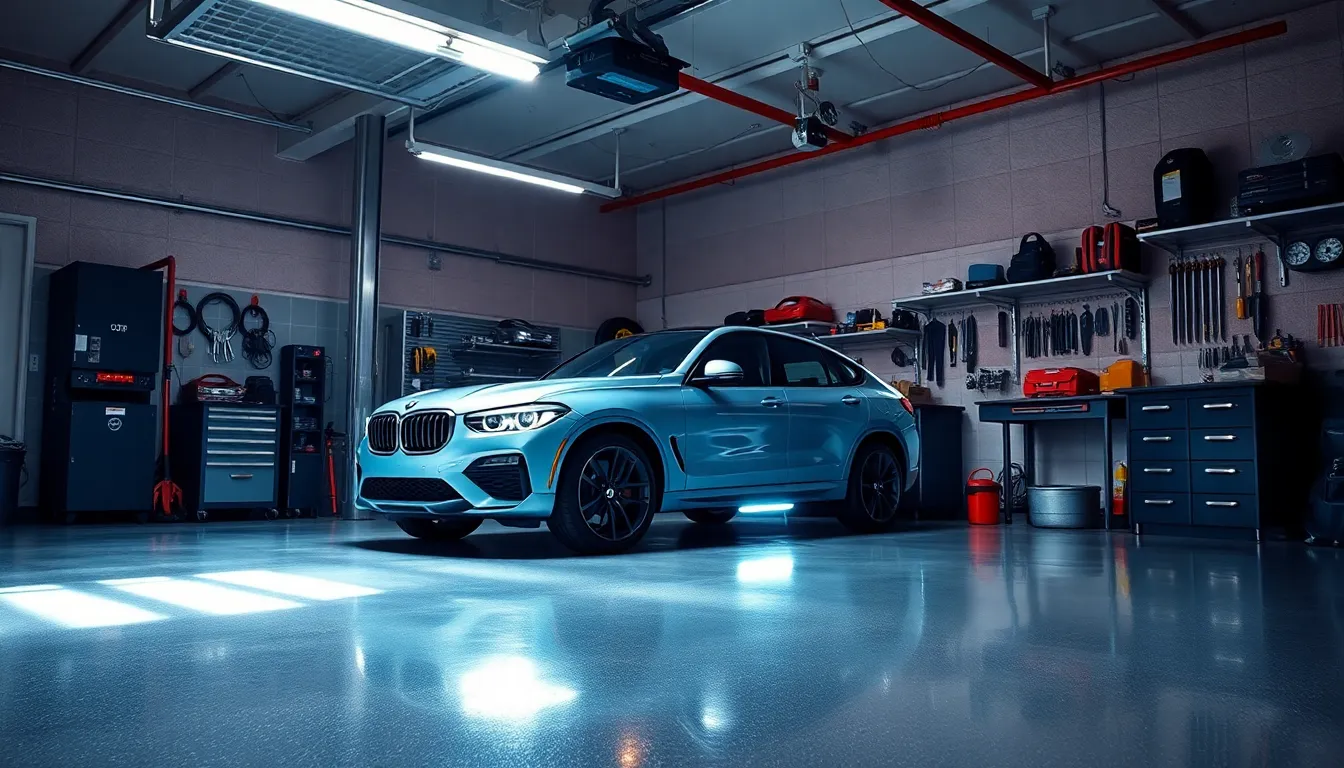
Smart investments in our garage space can significantly enhance both functionality and vehicle protection without very costly. Budget-friendly improvements deliver lasting value while creating a more professional automotive environment.
LED Lighting Installation
Upgrading to LED lighting systems transforms our garage workspace while reducing energy costs by up to 75% compared to traditional fluorescent bulbs. Professional-grade LED shop lights provide 4,000-6,000 lumens of bright, even illumination that eliminates shadows around parked vehicles. Motion-activated LED strips along garage door tracks ensure safe entry and exit during nighttime hours.
Installing under-cabinet LED lights creates focused task lighting for detailed maintenance work and vehicle inspections. These fixtures mount easily beneath existing shelving units and workbenches without requiring electrical modifications. Color temperature options between 4,000K and 5,000K deliver daylight-quality illumination that accurately reveals paint imperfections and mechanical issues.
Strategic placement of LED fixtures maximizes coverage while minimizing installation costs through careful planning of electrical runs. Corner-mounted LED flood lights eliminate blind spots behind vehicles, while overhead track lighting follows the garage’s natural traffic patterns. Battery-powered LED work lights provide portable illumination for engine compartments and undercarriage inspections.
Epoxy Floor Coating
Professional epoxy floor coatings create durable, chemical-resistant surfaces that protect concrete from oil stains, salt damage, and tire marks for 10-15 years. Two-part epoxy systems with decorative flakes cost $3-5 per square foot when applied DIY-style, compared to $8-12 for professional installation. These coatings cure to a glossy finish that reflects overhead lighting and makes the entire garage appear larger and brighter.
Preparation steps for epoxy application include diamond grinding or acid etching to ensure proper adhesion and long-term performance. Moisture testing with plastic sheeting confirms the concrete is ready for coating application, preventing future delamination issues. Temperature and humidity control during application ensures optimal curing conditions and professional-quality results.
Maintenance benefits of epoxy floors include easy cleanup with standard garage floor cleaners and resistance to hot tire pickup. Anti-slip additives in high-traffic areas provide safety without compromising the smooth finish that makes vehicle movement effortless. Recoat options every 5-7 years extend the floor’s lifespan and refresh its appearance at minimal cost.
Insulation Improvements
Adding insulation to garage walls and ceilings reduces energy costs by 20-30% while maintaining stable temperatures for vehicle storage year-round. R-13 fiberglass batts in 2×4 walls and R-30 blown-in insulation in attic spaces create thermal barriers that protect against extreme temperature fluctuations. Vapor barriers prevent moisture infiltration that leads to rust formation on metal vehicle components.
Insulating garage doors with retrofit kits improves temperature control at a fraction of new door replacement costs. Reflective foil panels and foam board inserts reduce heat transfer while maintaining door balance and operational smoothness. Weatherstripping around door perimeters eliminates drafts and prevents moisture intrusion during storms.
Cost-effective insulation materials include recycled denim batts and spray foam alternatives that provide excellent thermal performance without professional installation requirements. Rigid foam boards create continuous insulation layers that eliminate thermal bridging through wall studs. These upgrades typically pay for themselves within 3-4 years through reduced heating and cooling costs while creating more comfortable working conditions.
Seasonal Preparations for Cars in Garage
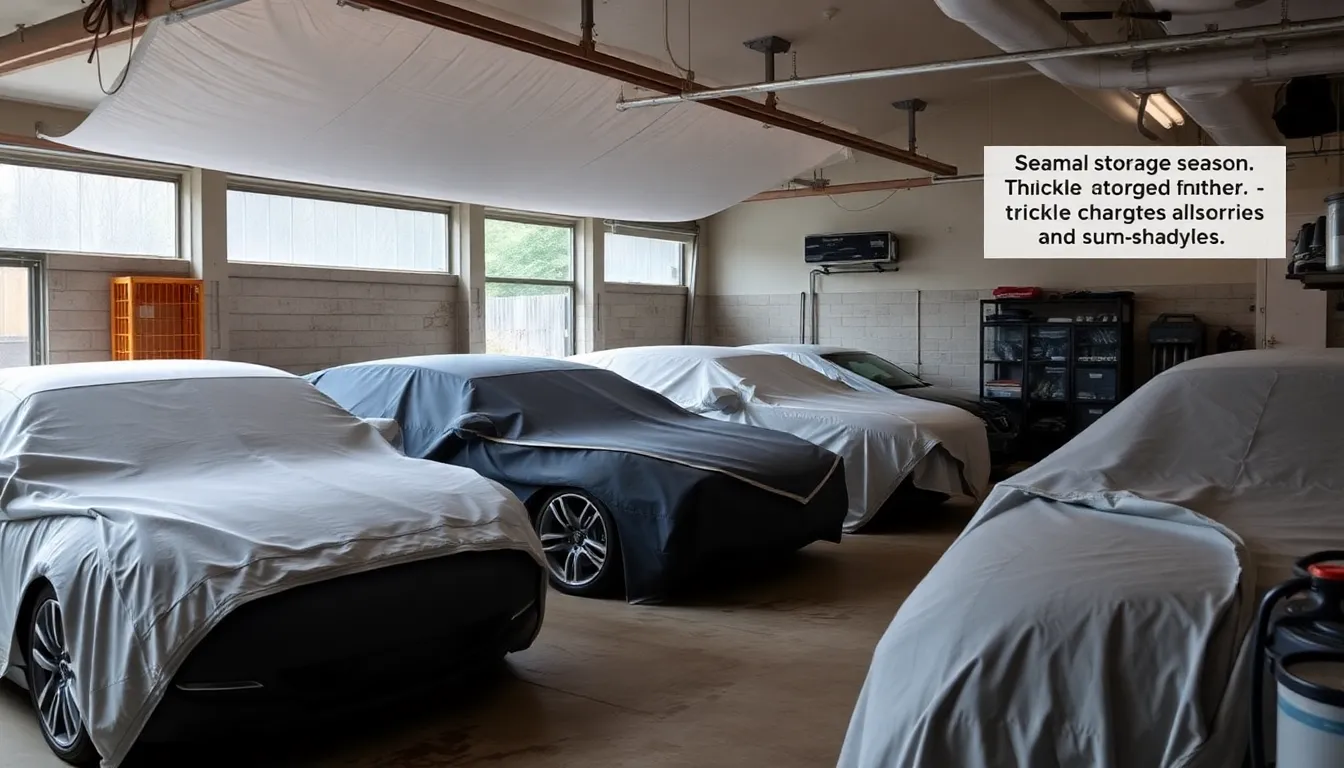
Preparing our garage stored vehicles for different seasons ensures optimal protection and performance year round. Each season brings unique challenges that require exact preparation strategies to maintain our automotive investments.
Winter Storage Protocols
Cold weather storage demands comprehensive preparation to protect our vehicles from harsh winter conditions. We recommend starting with a thorough engine service including fresh oil changes and coolant system flushes before extended storage periods.
Battery maintenance becomes critical during winter months. Disconnect the battery terminals and connect a trickle charger to prevent complete discharge. Store batteries in heated areas when temperatures drop below 32°F for extended periods.
Fuel system preparation prevents costly damage from condensation and ethanol separation. Fill the gas tank completely and add fuel stabilizer according to manufacturer specifications. Run the engine for 10 minutes after adding stabilizer to circulate the treated fuel throughout the system.
Tire pressure monitoring requires increased attention during cold storage. Check tire pressure weekly and inflate to manufacturer recommended PSI plus 5 pounds to compensate for cold weather pressure loss. Remove vehicles from storage and drive short distances monthly to prevent flat spots on tires.
Moisture control systems work overtime during winter storage periods. Place moisture absorbing products like DampRid containers in multiple locations throughout the vehicle interior. Leave windows cracked slightly to promote air circulation while maintaining security.
Summer Heat Protection
Extreme heat poses important threats to our garage stored vehicles during summer months. Temperature regulation becomes essential when garage temperatures exceed 90°F consistently.
Window protection prevents interior damage from UV rays and heat buildup. Install reflective sunshades on all windows and consider ceramic window tinting for long term protection. Park vehicles away from direct sunlight entering through garage windows or doors.
Cooling system maintenance prevents overheating during hot weather driving. Check coolant levels monthly and flush the system annually before summer season begins. Inspect radiator fins for debris buildup that reduces cooling efficiency.
Interior preservation requires proactive measures against heat damage. Apply UV protectant to leather seats, dashboard surfaces, and plastic trim pieces every 30 days. Use breathable car covers designed for indoor storage to prevent heat trapped moisture problems.
Ventilation enhancement keeps garage temperatures manageable during peak summer heat. Install exhaust fans rated for garage square footage and operate during hottest parts of the day. Open garage doors during early morning hours to allow cool air circulation.
Fluid monitoring becomes more frequent due to increased evaporation rates. Check brake fluid, power steering fluid, and transmission fluid levels every two weeks during summer storage. Top off fluids as needed using manufacturer specified products.
Spring Cleaning Routines
Spring preparation revitalizes our garage stored vehicles after winter dormancy periods. Comprehensive cleaning and inspection routines restore vehicles to peak operating condition.
Deep cleaning procedures remove accumulated dust and debris from extended storage. Vacuum interior surfaces thoroughly including floor mats, seat crevices, and trunk areas. Use microfiber cloths and appropriate cleaners for different surface materials.
Exterior restoration involves multiple step washing and protection processes. Begin with thorough rinse to remove loose debris, followed by two bucket washing method using pH neutral car shampoo. Apply fresh coat of wax or ceramic coating for protection against spring weather elements.
Mechanical system inspections identify potential issues before they become major problems. Check all fluid levels and top off as needed, inspect belts and hoses for cracking or fraying. Test air conditioning system operation and replace cabin air filter if needed.
Tire inspection reveals winter damage and prepares vehicles for driving season. Examine tread depth using penny test method and look for signs of uneven wear patterns. Rotate tires according to manufacturer recommendations and balance wheels if vibration occurs.
Preventive maintenance tasks prepare vehicles for increased driving during warmer months. Schedule oil changes and filter replacements based on storage duration rather than mileage accumulation. Test battery voltage and clean terminals to ensure reliable starting performance.
Modern Technology Integration for Cars in Garage
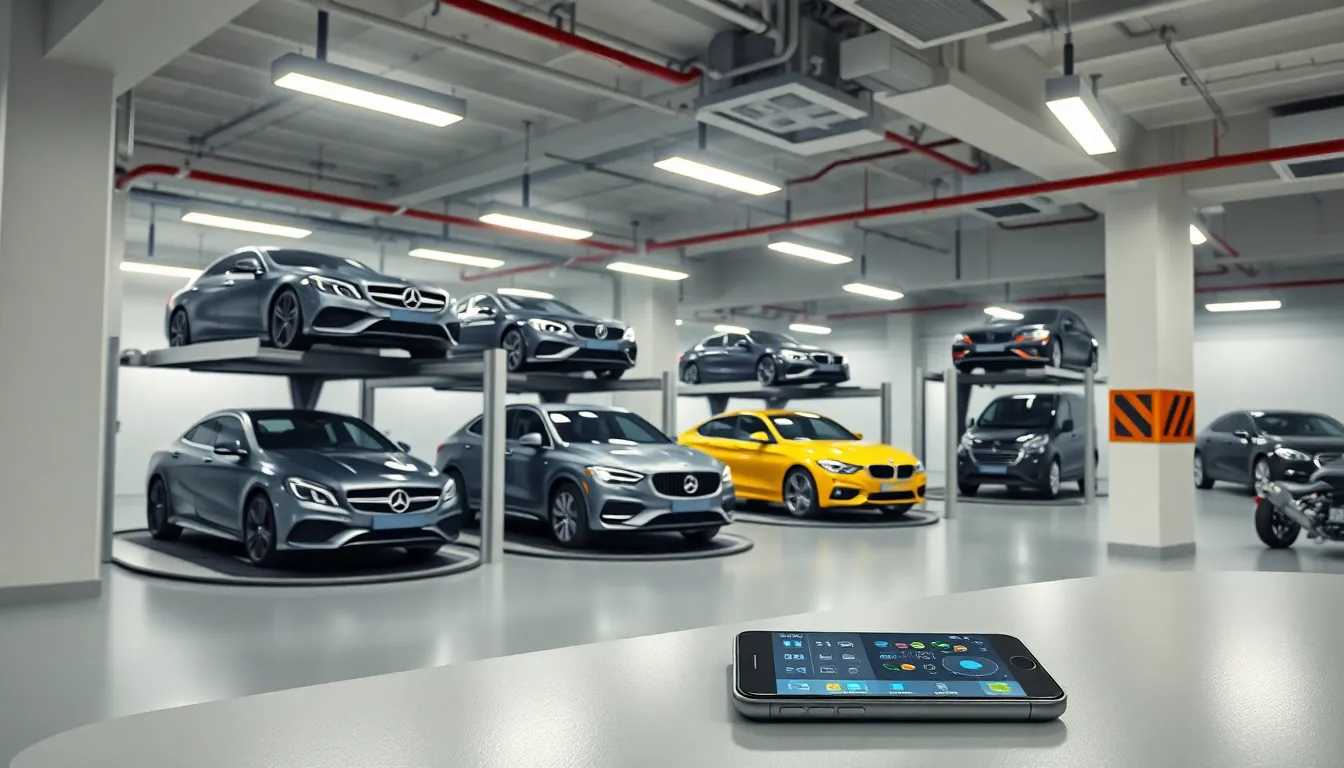
Today’s automotive storage answers benefit tremendously from cutting-edge technology that enhances convenience, security, and vehicle protection. We can transform our garage spaces into intelligent automotive sanctuaries through strategic technology integration.
Smart Garage Door Openers
Smart garage door openers revolutionize how we access and secure our automotive storage spaces. These advanced systems connect to WiFi networks and allow remote operation through smartphone applications from anywhere in the industry.
Voice Control Integration works seamlessly with Amazon Alexa, Google Assistant, and Apple HomeKit systems. We can simply say “open garage door” to activate the mechanism without searching for remotes or keypads.
Automatic Scheduling Features enable programmable opening and closing times based on our daily routines. The systems learn our patterns and can automatically open doors when we approach or close them after predetermined intervals.
Real Time Notifications alert us immediately when doors open or close unexpectedly. These security alerts include timestamps and can distinguish between authorized and unauthorized access attempts.
Battery Backup Systems ensure continued operation during power outages, maintaining access to our vehicles when we need them most. Most models provide 24-48 hours of emergency power for essential functions.
Automated Parking Systems
Automated parking systems maximize space utilization while protecting vehicles from damage during storage maneuvers. These sophisticated mechanisms handle parking tasks with precision that surpasses human capability.
Robotic Car Lifts transport vehicles vertically and horizontally within multi-level garage structures. The systems can accommodate 2-4 vehicles in the space traditionally required for one car, making them ideal for urban properties.
Guided Parking Sensors use laser and ultrasonic technology to direct vehicles into optimal positions. We receive audio and visual feedback through dashboard displays or mobile applications during parking procedures.
Turntable Platforms rotate parked vehicles 180 degrees, eliminating the need for backing out of tight spaces. These circular platforms typically measure 12-16 feet in diameter and support vehicles up to 6,000 pounds.
Mechanical Lift Systems create double-deck parking arrangements that store one vehicle above another. The systems operate on hydraulic or electric mechanisms and can lift vehicles up to 7 feet high within standard garage heights.
Mobile App Monitoring
Mobile applications provide comprehensive oversight of garage conditions and vehicle security from remote locations. These digital tools integrate multiple monitoring systems into unified control platforms.
Environmental Tracking monitors temperature, humidity, and air quality levels inside garage spaces through wireless sensors. We receive alerts when conditions exceed optimal ranges for vehicle storage, typically 32-100°F and 30-50% humidity.
Security Camera Access streams live video feeds directly to our smartphones, tablets, and computers. The applications store recorded footage for 7-30 days and send motion-triggered alerts with photo attachments.
Door Status Monitoring displays real-time information about garage door positions, lock status, and recent activity logs. We can verify closure status and receive notifications if doors remain open longer than specified time periods.
Vehicle Diagnostic Integration connects to onboard computer systems in modern vehicles, providing battery voltage readings, tire pressure data, and maintenance reminders. The applications can detect potential issues before they become serious problems requiring professional attention.
Conclusion
Creating the perfect automotive sanctuary requires thoughtful planning and strategic implementation of the right systems. We’ve explored everything from basic storage answers to advanced smart technology integration that can transform any garage space.
The investment in proper garage setup pays dividends through enhanced vehicle protection preservation of resale value and improved functionality. Whether you’re working with a single-car attached space or designing a multi-vehicle facility these principles remain consistent.
Your garage can become more than just storage—it’s an extension of your automotive passion. With the right climate control security measures and maintenance routines you’ll create a space that truly serves your vehicles and enhances your ownership experience.
Remember that every upgrade doesn’t need to happen overnight. Start with essential improvements and gradually build your ideal automotive environment as your needs and budget allow.
Frequently Asked Questions
What are the main benefits of storing a car in a garage?
Storing your car in a garage provides three key benefits: protection from weather elements like UV rays, rain, and extreme temperatures that can cause rust and paint damage; enhanced security since vehicles are hidden from potential thieves and can be integrated with home security systems; and preservation of vehicle value, with garage-stored cars maintaining up to 15% more resale value over five years.
What types of garages are best for automotive storage?
The best garage type depends on your needs: attached single-car garages offer convenient daily access and cost-effectiveness; detached multi-car garages provide expansive storage and customization options for multiple or valuable vehicles; and underground parking structures deliver maximum security and consistent temperature control, making them ideal for urban environments and premium vehicle protection.
How can I maximize storage space in my garage?
Maximize garage storage using three approaches: wall-mounted solutions like pegboard panels and magnetic tool strips for vertical space; overhead storage including pulley systems and suspended shelving to free up floor space; and floor optimization with modular wheeled cabinets, rolling toolboxes, and foldable workbenches that maintain vehicle access while organizing tools and equipment.
What climate control considerations are important for garage-stored vehicles?
Proper climate control requires temperature regulation through HVAC integration or mini-split systems, humidity management using dehumidifiers and vapor barriers to prevent rust, and adequate ventilation with natural or mechanical systems. Maintain temperatures between 50-70°F and humidity below 50% while ensuring proper air circulation to prevent moisture damage and gas accumulation.
What security measures should I implement for my garage?
Implement layered security with advanced door locks including smart locks and deadbolt reinforcements, motion sensor lighting for perimeter and interior areas, and high-definition security cameras with night vision capabilities. Integrate these systems with alarm systems and consider keypad entry systems for enhanced access control while deterring theft and unauthorized entry.
How often should I maintain my garage-stored vehicle?
Follow a regular maintenance schedule: wash weekly to prevent dust buildup, clean interior monthly, and wax quarterly to protect against humidity. Check battery voltage bi-weekly, inspect fluids monthly, and monitor tire pressure weekly with seasonal adjustments. This routine preserves vehicle integrity and performance during extended garage storage periods.
What common mistakes should I avoid when parking cars in garages?
Avoid inadequate space planning by measuring dimensions accurately and ensuring proper door clearance. Don’t block natural air circulation or install inadequate ventilation systems. Never neglect regular maintenance checks on garage doors, security systems, and pest control. Ensure clear walking paths around vehicles and maintain proper clearance for safe entry and exit.
What are some cost-effective garage upgrades for vehicle protection?
Install LED lighting to reduce energy costs and improve visibility, apply epoxy floor coatings to protect concrete and enhance appearance, and add insulation to maintain stable temperatures. These budget-friendly upgrades create a more professional automotive environment while providing long-term value and better vehicle protection without significant investment.
How should I prepare my garage-stored vehicle for different seasons?
Winter preparation includes engine servicing, battery maintenance, fuel system prep, and moisture control. Summer requires window protection, cooling system maintenance, enhanced ventilation, and fluid monitoring. Spring cleaning involves deep cleaning, exterior restoration, mechanical inspections, tire checks, and preventive maintenance to ensure vehicles are ready for driving season.
What modern technology can enhance my automotive garage storage?
Integrate smart garage door openers with smartphone apps and voice control, automated parking systems with robotic lifts and guided sensors to maximize space, and mobile app monitoring for environmental tracking and security camera access. These technologies transform garages into intelligent automotive sanctuaries, enhancing convenience, security, and vehicle protection through advanced automation.

